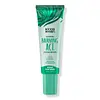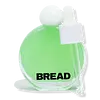What's inside
What's inside
 Key Ingredients
Key Ingredients

 Benefits
Benefits

 Concerns
Concerns

 Ingredients Side-by-side
Ingredients Side-by-side

Water
Skin ConditioningGlycerin
HumectantCetyl Alcohol
EmollientLactic Acid
BufferingIsopentyldiol
HumectantHamamelis Virginiana Water
AstringentGlycolic Acid
BufferingVaccinium Myrtillus Fruit Extract
Skin ConditioningCitrus Aurantium Dulcis Fruit Extract
MaskingCitrus Limon Fruit Extract
MaskingAcer Saccharum Extract
Skin ConditioningCitric Acid
BufferingTartaric Acid
BufferingMalic Acid
BufferingMenthol
MaskingSea Water
HumectantLaminaria Digitata Extract
Skin ProtectingChlorella Vulgaris Extract
Skin ConditioningSaccharide Isomerate
HumectantLavandula Stoechas Extract
MaskingPropanediol
SolventLycium Barbarum Fruit Extract
AstringentCetearyl Alcohol
EmollientCeteareth-20
CleansingCaesalpinia Spinosa Gum
Skin ConditioningAcrylamidopropyltrimonium Chloride/Acrylates Copolymer
Isohexadecane
EmollientCoceth-7
EmulsifyingParfum
MaskingLimonene
PerfumingTetrasodium Glutamate Diacetate
Phenoxyethanol
PreservativeEthylhexylglycerin
Skin ConditioningWater, Glycerin, Cetyl Alcohol, Lactic Acid, Isopentyldiol, Hamamelis Virginiana Water, Glycolic Acid, Vaccinium Myrtillus Fruit Extract, Citrus Aurantium Dulcis Fruit Extract, Citrus Limon Fruit Extract, Acer Saccharum Extract, Citric Acid, Tartaric Acid, Malic Acid, Menthol, Sea Water, Laminaria Digitata Extract, Chlorella Vulgaris Extract, Saccharide Isomerate, Lavandula Stoechas Extract, Propanediol, Lycium Barbarum Fruit Extract, Cetearyl Alcohol, Ceteareth-20, Caesalpinia Spinosa Gum, Acrylamidopropyltrimonium Chloride/Acrylates Copolymer, Isohexadecane, Coceth-7, Parfum, Limonene, Tetrasodium Glutamate Diacetate, Phenoxyethanol, Ethylhexylglycerin
Water
Skin ConditioningBrassica Oleracea Italica Sprout Extract
EmollientGluconolactone
Skin ConditioningCoffea Arabica Leaf/Seed Extract
MaskingMelia Azadirachta Leaf Extract
Skin ConditioningMelia Azadirachta Flower Extract
Skin ConditioningSerenoa Serrulata Fruit Extract
Skin ConditioningPrunus Serrulata Flower Extract
Skin ConditioningPalmaria Palmata Extract
Skin ProtectingDavidsonia Jerseyana Fruit Extract
AntioxidantAnanas Sativus Fruit Extract
Skin ConditioningHelianthus Annuus Seed Extract
Skin ConditioningCupressus Sempervirens Leaf/Stem Extract
Skin ConditioningCentella Asiatica Extract
CleansingCamellia Sinensis Leaf Extract
AntimicrobialBackhousia Anisata Leaf Extract
EmollientScutellaria Baicalensis Root Extract
AstringentTriticum Vulgare Germ Extract
Skin ConditioningGlycine Soja Germ Extract
EmollientCoenochloris Signiensis Extract
Skin ConditioningGlycerin
HumectantArginine
MaskingLactic Acid
BufferingTocopherol
AntioxidantHydroxyethylcellulose
Emulsion StabilisingEthylhexylglycerin
Skin ConditioningPropanediol
SolventMandelic Acid
AntimicrobialMaltodextrin
AbsorbentMenthol
MaskingMenthyl Lactate
MaskingSodium Nitrate
SoothingPolysorbate 60
EmulsifyingDisodium Phosphate
BufferingMenthone
PerfumingLimonene
PerfumingL-Menthanone
PerfumingEucalyptol
PerfumingD-Pulegone
PerfumingBeta-Caryophyllene
MaskingNeomenthol
PerfumingSodium Phosphate
BufferingPinene
MaskingSodium Benzoate
MaskingLecithin
EmollientGlyoxal
AntimicrobialCalcium Gluconate
HumectantPhenoxyethanol
PreservativeWater, Brassica Oleracea Italica Sprout Extract, Gluconolactone, Coffea Arabica Leaf/Seed Extract, Melia Azadirachta Leaf Extract, Melia Azadirachta Flower Extract, Serenoa Serrulata Fruit Extract, Prunus Serrulata Flower Extract, Palmaria Palmata Extract, Davidsonia Jerseyana Fruit Extract, Ananas Sativus Fruit Extract, Helianthus Annuus Seed Extract, Cupressus Sempervirens Leaf/Stem Extract, Centella Asiatica Extract, Camellia Sinensis Leaf Extract, Backhousia Anisata Leaf Extract, Scutellaria Baicalensis Root Extract, Triticum Vulgare Germ Extract, Glycine Soja Germ Extract, Coenochloris Signiensis Extract, Glycerin, Arginine, Lactic Acid, Tocopherol, Hydroxyethylcellulose, Ethylhexylglycerin, Propanediol, Mandelic Acid, Maltodextrin, Menthol, Menthyl Lactate, Sodium Nitrate, Polysorbate 60, Disodium Phosphate, Menthone, Limonene, L-Menthanone, Eucalyptol, D-Pulegone, Beta-Caryophyllene, Neomenthol, Sodium Phosphate, Pinene, Sodium Benzoate, Lecithin, Glyoxal, Calcium Gluconate, Phenoxyethanol
Ingredients Explained
These ingredients are found in both products.
Ingredients higher up in an ingredient list are typically present in a larger amount.
Ethylhexylglycerin (we can't pronounce this either) is commonly used as a preservative and skin softener. It is derived from glyceryl.
You might see Ethylhexylglycerin often paired with other preservatives such as phenoxyethanol. Ethylhexylglycerin has been found to increase the effectiveness of these other preservatives.
Glycerin is already naturally found in your skin. It helps moisturize and protect your skin.
A study from 2016 found glycerin to be more effective as a humectant than AHAs and hyaluronic acid.
As a humectant, it helps the skin stay hydrated by pulling moisture to your skin. The low molecular weight of glycerin allows it to pull moisture into the deeper layers of your skin.
Hydrated skin improves your skin barrier; Your skin barrier helps protect against irritants and bacteria.
Glycerin has also been found to have antimicrobial and antiviral properties. Due to these properties, glycerin is often used in wound and burn treatments.
In cosmetics, glycerin is usually derived from plants such as soybean or palm. However, it can also be sourced from animals, such as tallow or animal fat.
This ingredient is organic, colorless, odorless, and non-toxic.
Glycerin is the name for this ingredient in American English. British English uses Glycerol/Glycerine.
Learn more about GlycerinLactic Acid is another well-loved alpha hydroxy acid (AHA). It is gentler than glycolic acid but still highly effective.
Its main role is to exfoliate the surface of the skin by loosening the “glue” that holds dead skin cells together. Shedding those old cells leads to smoother, softer, and more even-toned skin.
Because lactic acid molecules are larger than glycolic acid, they don’t penetrate as deeply. This means they’re less likely to sting or irritate, making it a great choice for beginners or those with sensitive skin.
Like glycolic acid, it can:
Lactic acid also acts as a humectant (like hyaluronic acid). It can draw water into the skin to improve hydration and also plays a role in the skin's natural moisturizing factor (NMF) in the form of sodium lactate.
Studies show it can boost ceramide production to strengthen the skin barrier and even help balance the skin’s microbiome.
To get results, choose products with a pH between 3-4.
Lower strengths (5-12%) focus on surface exfoliation; higher strengths (12% and up) can reach deeper in the dermis (deeper, supportive layer) to improve skin texture and firmness over time.
Though it was originally derived from milk, most modern lactic acid used in skincare is vegan. It is made through non-dairy fermentation to create a bio-identical and stable form suitable for all formulations.
When lactic acid shows up near the end of an ingredient list, it usually means the brand added just a tiny amount to adjust the product’s pH.
Legend has it that Cleopatra used to bathe in sour milk to help reduce wrinkles.
Lactic acid is truly a gentle multitasker: it exfoliates, hydrates, strengthens, and brightens. It's a great ingredient for giving your skin a smooth, glowing, and healthy look without the harshness of stronger acids.
Read more about some other popular AHA's here:
Learn more about Lactic AcidLimonene is a fragrance that adds scent and taste to a formulation.
It's found in the peel oil of citrus fruits and other plants such as lavender and eucalyptus. The scent of limonene is generally described as "sweet citrus".
Limonene acts as an antioxidant, meaning it helps neutralize free radicals.
When exposed to air, oxidized limonene may sensitize the skin. Because of this, limonene is often avoided by people with sensitive skin.
The term 'fragrance' is not regulated in many countries. In many cases, it is up to the brand to define this term. For instance, many brands choose to label themselves as "fragrance-free" because they are not using synthetic fragrances. However, their products may still contain ingredients such as essential oils that are considered a fragrance.
Learn more about LimoneneMenthol is a compound found in mint plants, such as peppermint. In its pure form, it is a clear crystalline substance.
Menthol is known for its cooling sensation; however, the cooling is actually from your skin being sensitized. Menthol can worsen rosacea. We recommend speaking with a professional if you have concerns.
Menthol also has antimicrobial properties.
Learn more about MentholPhenoxyethanol is a preservative that has germicide, antimicrobial, and aromatic properties. Studies show that phenoxyethanol can prevent microbial growth. By itself, it has a scent that is similar to that of a rose.
It's often used in formulations along with Caprylyl Glycol to preserve the shelf life of products.
Propanediol is an all-star ingredient. It softens, hydrates, and smooths the skin.
It’s often used to:
Propanediol is not likely to cause sensitivity and considered safe to use. It is derived from corn or petroleum with a clear color and no scent.
Learn more about PropanediolWater. It's the most common cosmetic ingredient of all. You'll usually see it at the top of ingredient lists, meaning that it makes up the largest part of the product.
So why is it so popular? Water most often acts as a solvent - this means that it helps dissolve other ingredients into the formulation.
You'll also recognize water as that liquid we all need to stay alive. If you see this, drink a glass of water. Stay hydrated!
Learn more about Water